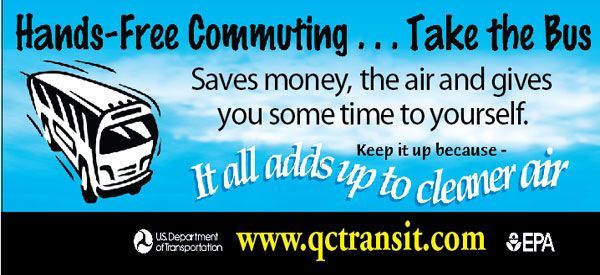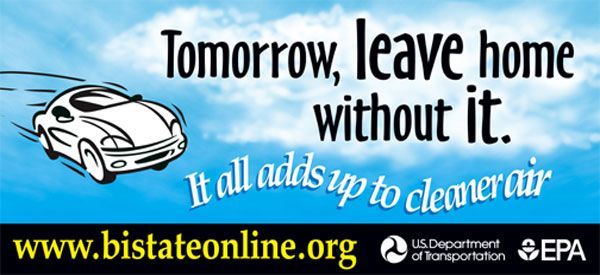 The good news is the Bi-State Region doesn’t have severe air pollution. The bad news is there have been days when air quality has been considered poor or unhealthy. These days have typically occurred between the months of May and September, our “Ozone Season” or in mid-winter and winter for fine particulates. A Bi-State Region Air Quality Task Force, formed in 1998, is making strides to raise awareness and encourage reductions in activities that contribute to smog and fine particles. The Task Force is composed of local public works officials, transit operators, representatives of major industries, state resource agencies, universities and interested citizens. For more information, download the materials below.
The good news is the Bi-State Region doesn’t have severe air pollution. The bad news is there have been days when air quality has been considered poor or unhealthy. These days have typically occurred between the months of May and September, our “Ozone Season” or in mid-winter and winter for fine particulates. A Bi-State Region Air Quality Task Force, formed in 1998, is making strides to raise awareness and encourage reductions in activities that contribute to smog and fine particles. The Task Force is composed of local public works officials, transit operators, representatives of major industries, state resource agencies, universities and interested citizens. For more information, download the materials below.
Daily Air Quality

http://www.airnow.gov
Color contours of measured Air Quality Index values show ozone levels across the specified geographic area. Maps are currently available for 38 states, the District of Columbia and parts of Canada. Complete with map archives and animation that reflects 8-hour average concentrations, calculated from observed 1-hour data.
What Is Ozone?
Ozone is a highly reactive, complex form of oxygen. In the upper atmosphere, ozone protects the earth from ultraviolet radiation. At ground level where we breath, too much ozone is a pollutant. Elevated amounts of ozone are linked to increased respiratory illness and reduction of lung function. Persons may experience symptoms such as chest pains and coughing when exposed to relatively low levels of ozone during moderate periods of exercise. Children, elderly and persons with existing respiratory problems are especially sensitive to the effects of ozone.
How Is Ozone Formed?
Ground level ozone, often called smog, is formed when hydrocarbons (volatile organic compounds or VOCs) and nitrogen oxides (Nox) mix with the energy from the sun. A hot, sunny day with stagnant air provides the basis for the sun to heat up these pollutants. A variety of sources contribute to the mix of pollutants. Sources of VOCs and NOx include emissions from transportation (motor vehicles), fuel combustion (power plants), industrial processes (factories) and consumer, commercial products (paints and solvents).
Unhealthy Episodes
Since Fall 1998, the Bi-State Region, Iowa/Illinois has been alerted by the Iowa Department of Natural Resources (IADNR) and Illinois Environmental Protection Agency (ILEPA) that the metropolitan area and small urbaqn communities such as Muscatine, Iowa have experienced a few days where air quality levels in the atmosphere have been considered unhealthy. Although the general air quality in the Bi-State Region is considered good by many of the standards for pollutants, there are recent National Ambient Air Quality Standards that have revised thresholds for concentrations of ozone in the lower atmosphere and fine particulates based on health considerations. It is this health-based threshold that concern area officials and the state agencies.
In reaction to this news, the Bi-State Region Air Quality Task Force watches the ozone and fine particulates situation and implements education efforts within the community in order to improve air quality.
Who's Involved?
Everyone is involved! Each person can make a difference. Local, state and federal officials and businesses in the Bi-State Region are working together to raise awareness and maintaining good air quality. Voluntary efforts by each of us can have a cumulative effect on air pollution during the most critical days of the year. This "Aware of Air" website is one effort to raise awareness and educate citizens and local officials on ways to help reduce air pollution episodes in the Bi-State Region.
What You Can Do To Improve Air Quality Today and Tomorrow
Find out how you can make an impact on improving air quality in the Bi-State Region. There are simple actions individuals can take to reduce unhealthy air emissions.
Each individual can make a difference in air quality. Try these suggestions to help reduce ground level ozone in the Quad Cities, Iowa/Illinois:
- Bicycle, walk, car or van-pool or use the bus instead of using your car or truck.
- Avoid congested roads or bridges by taking another route.
- Avoid excessive idling and abrupt starts and stops in traffic, at the drive-through window or waiting for your child.
- Avoid operating gas-powered lawn equipment when the weather is very hot. If you cannot postpone the activity then try to delay it until late in the day. Or better yet, use electric-powered lawn equipment.
- Postpone painting, varnishing or finishing work on hot days.
- Barbecue with an electric starter or charcoal chimney instead of using lighter fluid.
- Conserve energy in your home to reduce energy need from power plants.
- Replace incandescent light bulbs with compact fluorescent light bulbs.
- Use alternative fuels, such as ethanol, propane, bio-diesel, natural gas, electric or solar.
- Try working at home using the phone or your home computer instead of driving to work.
- Bring a sack lunch to work instead of going out for lunch.
- Maintain propane tanks with periodic check ups.
- Maintain your vehicles and tightly close gas caps on your vehicle, personal watercraft and your gas-powered lawn equipment.
It All Adds Up To Cleaner Air
![]() Trip Chaining Ad.mp3 (469.41 kB)
Trip Chaining Ad.mp3 (469.41 kB)
![]() Alternative Transportation Ad.mp3 (466.15 kB)
Alternative Transportation Ad.mp3 (466.15 kB)
![]() Vehicle Maintenance Ad.mp3 (469.41 kB)
Vehicle Maintenance Ad.mp3 (469.41 kB)
pdf 2014-make-outdoor-air-quality-visible-stategic-plan.pdf(2.58 MB)
pdf EcoDriving Manual.pdf (1.46 MB)
pdf Transit Fact Sheet.pdf (33.06 kB)
pdf Ozone Season.pdf (39.22 kB)
Billboard images:


